�
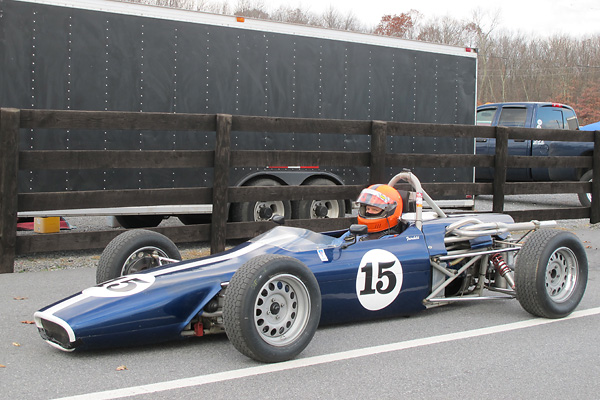
�
Dave Fairchild's 1969 Merlyn 11A Formula Ford Racecar
� � Owner: Dave Fairchild� City: Richmond Virginia
� Model: 1969 Merlyn Eleven-A
� Engine: 1.6L Ford four-cylinder
� Restored and race prepared by: Dave and his son Scott�
�
Colchester Racing Developments and the Merlyn 11A Model
��
Merlyn racecars are the most famous products of a family business named Colchester Racing Developments Ltd.�
Brother Selwyn Hayward first designed and built a Formula Junior racecar for personal use in 1960. It�
must have went well, because he was soon at work developing a Mk2 version. (Four were built.)�
Selwyn proved to be a skilled manager and marketeer. His brother Clive joined in the business, and�
ultimately proved to be a very gifted designer. Through the sixties and early seventies CRD's principle�
business was construction of racecars, stabilized by a successful side business in precision machine work�
and fabrication. Having particular skill in "making things" was a competitive advantage because compared�
to most other small racecar constructors CRD was able to produce a greater range of parts in house.�
�
The Merlyn Mk10 model was initially developed for Formula Three. When Formula Ford exploded onto�
the scene, Merlyn was ready to follow on the heels of Lotus. They simplified and cost-reduced�
their existing Formula Three design and fitted a Ford Kent engine to rapidly create a new Formula Ford�
model. The Merlyn 11 was available for purchase in 1968, but sales didn't really explode until�
1969 when the slightly updated Merlyn 11A was introduced. Orders flooded in from all quarters.�
A high percentage of Merlyn's orders came from North America. �
�
�

�
MERLYN
�
Chassis No.: 171 FF 69 / Mark: XI A
�
Manufactured by:
�
Colchester Racing Developments Ltd.
�
Colchester, Essex, England
�
�
The most famous Merlyn 11A became known retrospectively as the "Magic Merlyn". Chassis number 238 was�
owned and driven by a young Emerson Fittipaldi in 1969. Fittipaldi drove his 11A for less than a�
full season before distinguishing himself and moving on to Formula 3. By the end of 1970 he had won his�
first Formula One race. Fittipaldi sold his 11A to Colin Vandervell, son of the famous engine bearing�
mogul. Colin Vandervell drove chassis number 238 to many race victories in 1970, and swept the British�
Formula Ford championships. Vandervell then sold that very same Merlyn 11A to a youngster named�
Jody Scheckter. Scheckter only won one of his eleven races in the Magic Merlyn, but he credits the�
car and his time racing it while simultaneously working at the CRD works for teaching him the�
subtle art of car set-up and handling. Scheckter followed Fittipaldi to Formula One, where both men�
ultimately won world championships.�
�
Through the early seventies Merlyn remained in the top echelon of Formula Ford constructors. �
Ultimately however, tool and die work would became a much more lucrative part of the company's�
business. In 1979 the Haywards decided to withdraw from racecar production. CRD Tool and Engineering�
Limited remains in business to this day and still offers Merlyn spare parts.�
�
 �
�
�
�
Features and Specifications
�| Engine: | �1.6L Ford four-cylinder engine, built by Quicksilver RacEngines.�
Weber 32/36 DGV carburetor.�
Ramair model FF65 air filter.�
Bosch distributor.�
Pertronix Ignitor breakerless ignition module. �
Bosch blue ignition coil.�
Taylor Spiro Pro 8mm spark plug wires.�
Micro Dynamics "Rev Master" digital rev limiter.�
Dry sump lubrication system. | �
| Cooling: | �custom 22-row crossflow aluminum radiator.�
Mocal nine row oil cooler. | �
| Exhaust: | �four into one header, ceramic coated. | �
| Transmission: | �Hewland Mk9 (H9-6370) 4-speed.�
9.31 crown wheel and pinion (i.e. 3.44:1 final drive ratio.)�
Open differential.�
Tilton 7.25" clutch. | �
| Front Susp.: | �unequal length wide-based wishbones.�
Triumph (Alford & Alder, forged) uprights.�
Koni aluminum bodied double adjustable coilover shock absorbers.�
Eibach springs.�
Adjustable anti-sway bar. | �
| Rear Susp.: | �inverted lower wishbones, single top links, and twin adjustable trailing links.�
Proprietary Merlyn magnesium uprights.�
Koni aluminum bodied double adjustable coilover shock absorbers. �
Eibach springs.�
Adjustable anti-sway bar. | �
| Brakes: | �(master) dual Girling master cylinders with Tilton remotely adjustable bias bar, � (front) Girling 14LF calipers. Brembo rotors. Hawk "blue" pads, � (rear) Girling 12SP calipers. Brembo rotors. Hawk "blue" pads. | �
| Wheels/Tires: | �steel disc wheels. �
Dunlop Racing "Formula Ford" tires (135/545-13 CR82 front, 165/580-13 CR82 rear). | �
| Electrical: | �DMS/Varley red top battery (mounted under seat).�
Tilton Super Starter. | �
| Instruments: | �(left to right) AutoMeter oil temperature gauge (140-280F),�
Jones tachometer (1000-8000rpm),�
Racetech dual oil pressure (0-100psi) and coolant temperature (30-110C) gauge. �
AutoMeter hour meter (mounted on front bulkhead). | �
| Fuel System: | �under seat fuel cell. FF1600 fuel pump with push-on fittings. | �
| Safety Eqmt: | �custom-fitted drivers seat.�
Willans six-point cam-lock safety harness.�
FireBottle fire suppression system.�
Quick release steering wheel hub, on a RaceTech suede covered steering wheel. | �
| Weight: | �~925 pounds. | �
| Racing Class: | �Formula Ford | �
Engine Installation
��
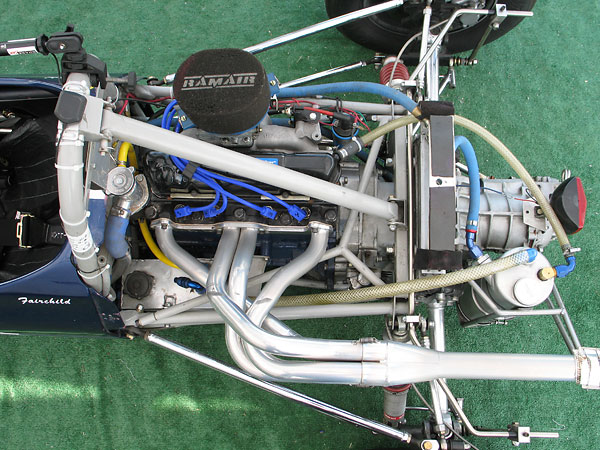
�
1.6L Ford four-cylinder engine, built by Quicksilver RacEngines.
�
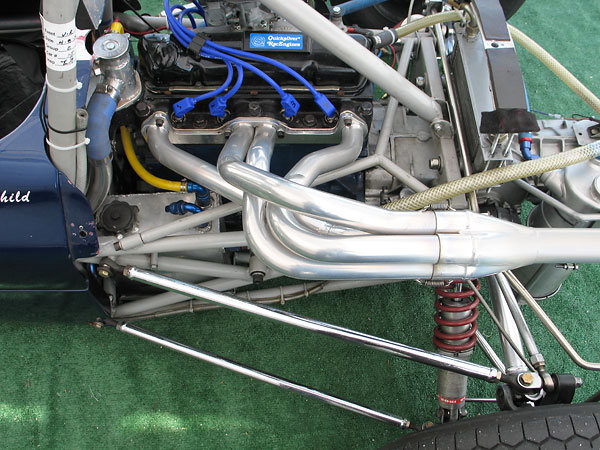
�
Four into one header, ceramic coated.
�
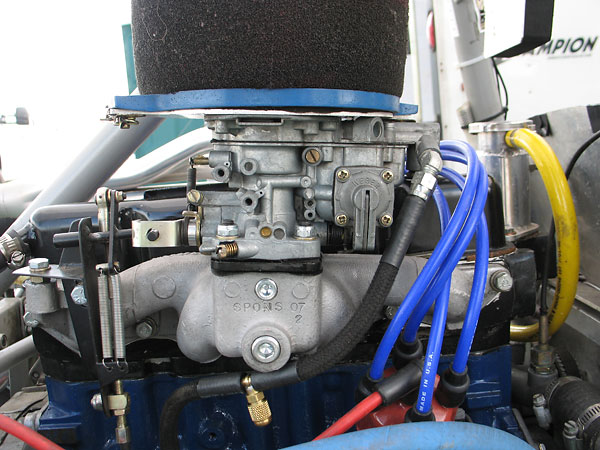
�
Weber 32/36 DGV carburetor. Ramair model FF65 air filter.
�
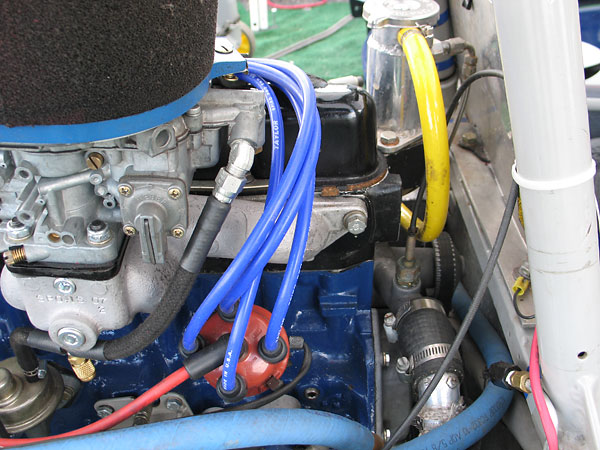
�
Bosch distributor with Pertronix Ignitor breakerless ignition module inside.
�
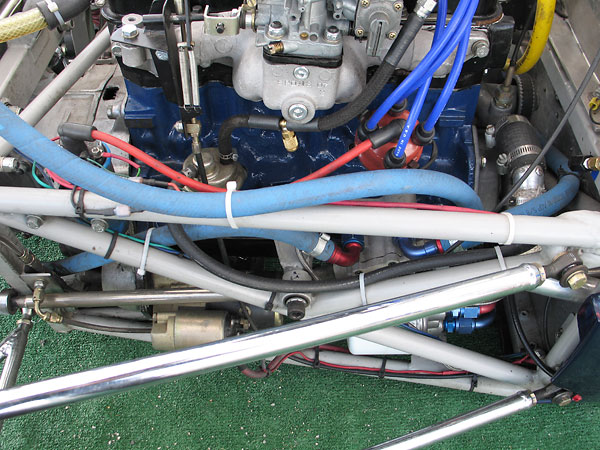
�
Bosch "blue" ignition coil and Taylor Spiro Pro 8mm spark plug wires.
�
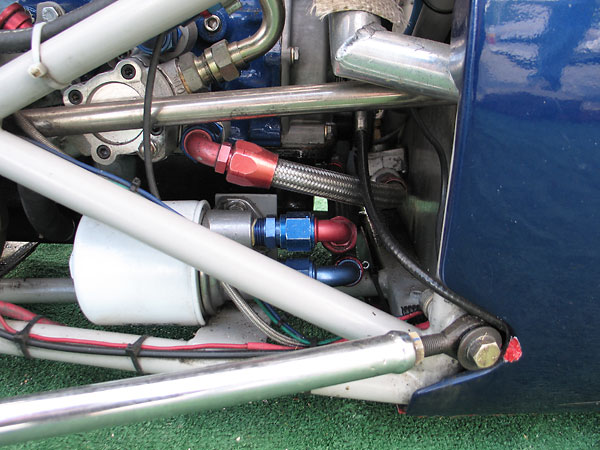
�
BAT oil pump cover.
�
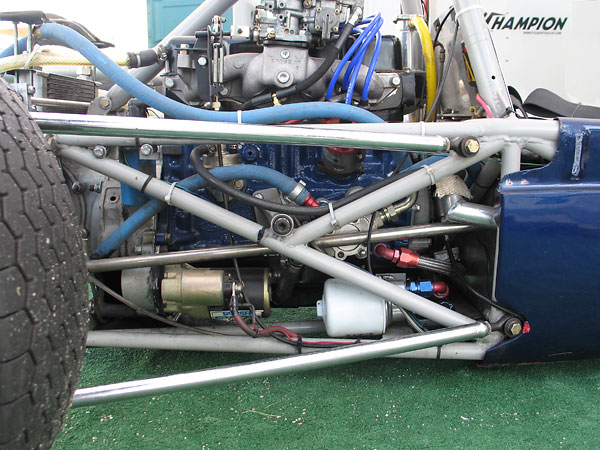
�
Tilton Super Starter.
�
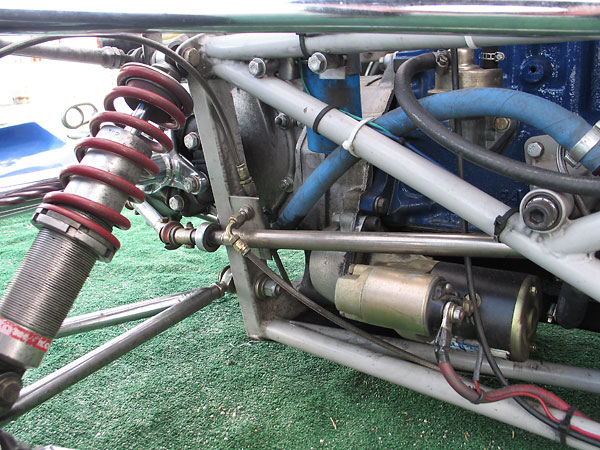
�
FF1600 fuel pump with push-on fittings.
�
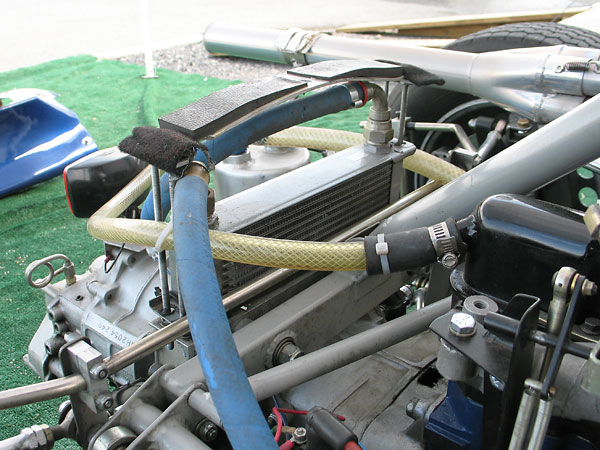
�
Mocal nine row oil cooler.
�
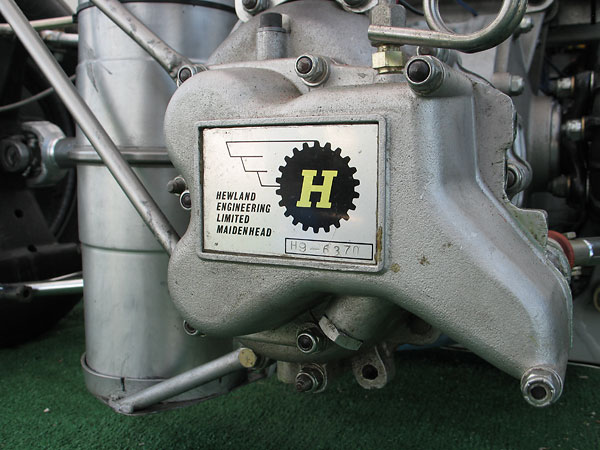
�
Hewland Mk9 (H9-6370) 4-speed.
�
�
Enjoying this article? www.BritishRaceCar.com is partially funded through generous support from readers like you!
�
To contribute to our operating budget, please click here and follow the instructions.
�
(Suggested contribution is twenty bucks per year. Feel free to give more!)�
Front Suspension
��
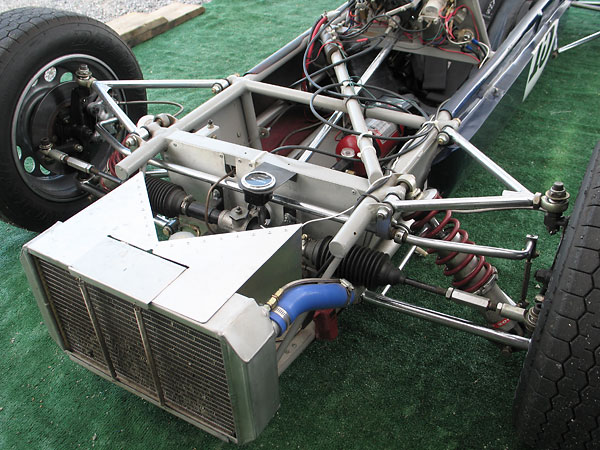
�
Engine coolant was originally routed through frame tubes, but now the tubes have been capped off.
�
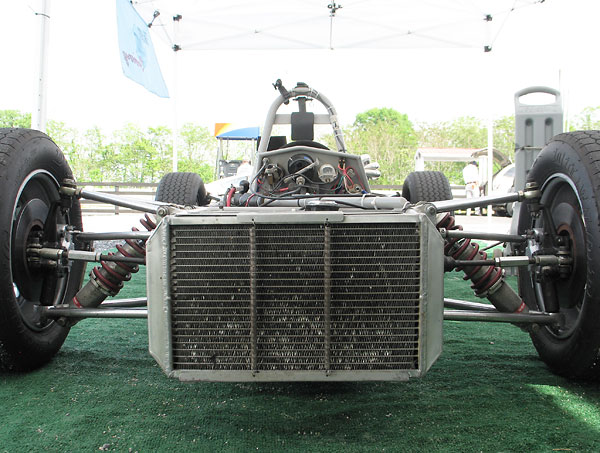
�
This large, aluminum crossflow radiator is a modern upgrade.
�
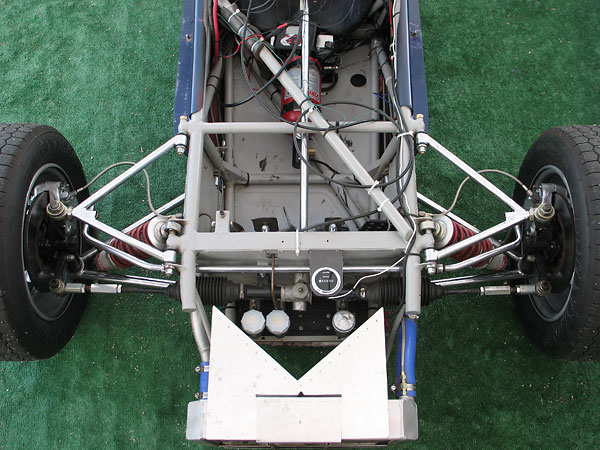
�
Airflow from the radiator core is diverted off to either side, and exits at suspension openings.
�
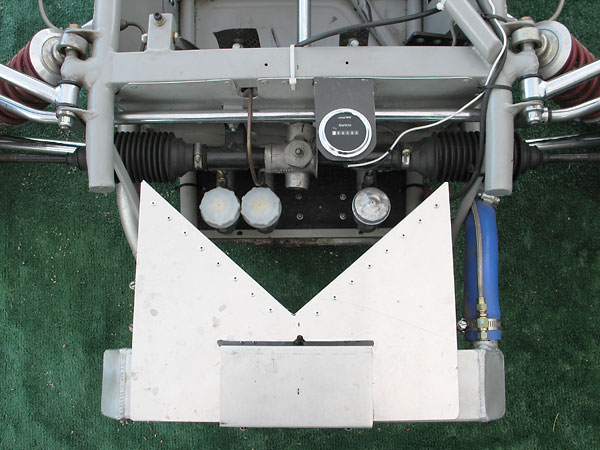
�
Dual Girling master cylinders with bias bar.
�
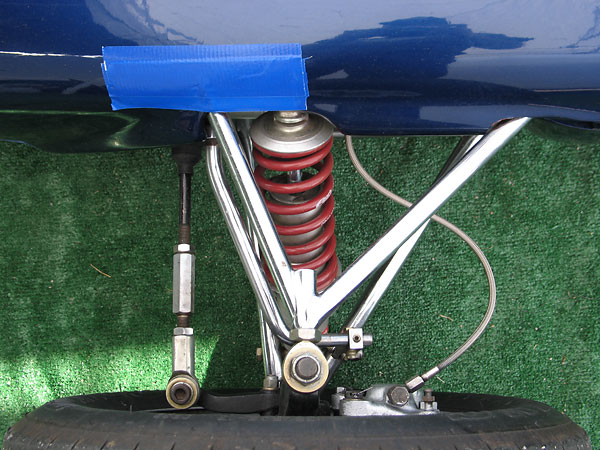
�
Only very minimal tuning of front suspension geometry is feasible because the control arms have
�
fixed-length ends instead of threaded Heim joints in ten of twelve possible positions.
�
This particular Heim joint appears to be adjusted to the very limit of its range.
�
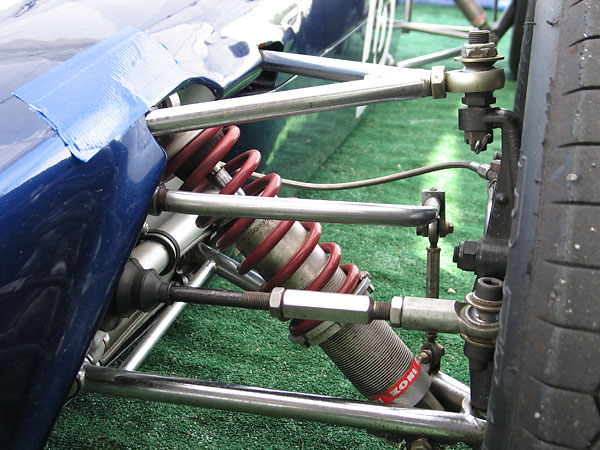
�
Koni aluminum bodied double adjustable coilover shock absorbers and Eibach springs.
�
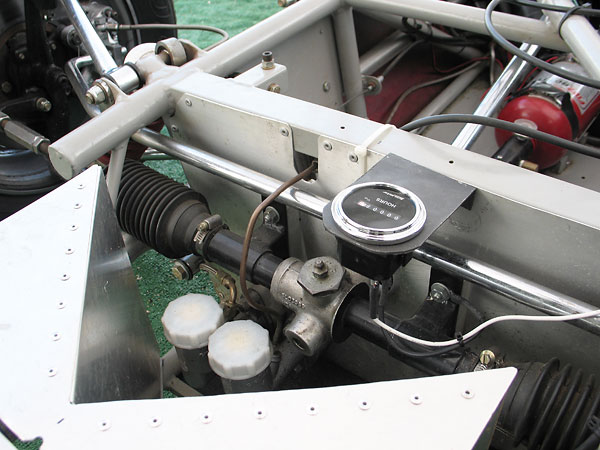
�
Cut-down steering rack.
�
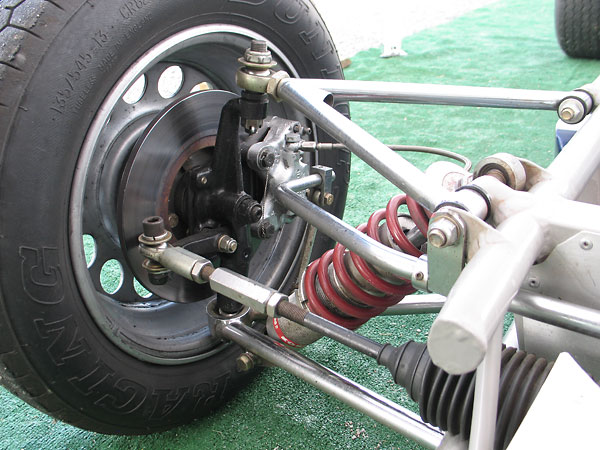
�
This nifty steering adapter has a left-hand female thread and a right-hand male thread to make
�
toe adjustments quick and simple. Just rotate the adapter to change its installed length.
�
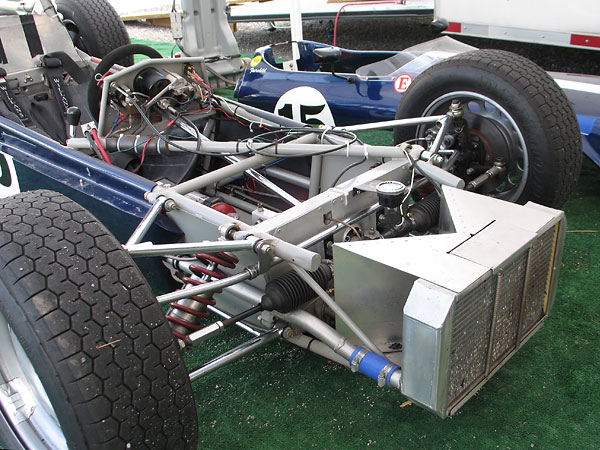
�
Triangulation, the installation of frame members that span rectangular bays to connect opposite nodes,
�
provides a great boost to chassis rigidity and strength. Without adequate triangulation, welded joints are
�
more heavily stressed. A distinctive feature of Merlyn 11/11A frames is a peculiar out-of-plane diagonal
�
that spans from the top lefthand corner of the front bulkhead to the righthand edge of the dashboard.
�
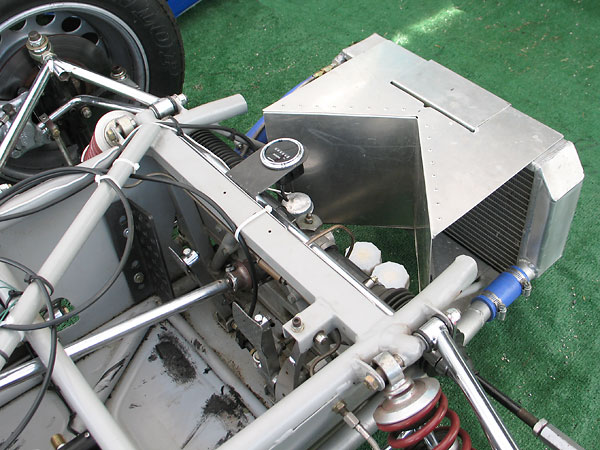
�
Another way to triangulate a four bar linkage is to install a stressed skin. Here, both sides of the
�
footbox have steel sheetmetal stitch-welded into place. If these panels had extended rearward down
�
the length of the driver compartment, they would've been in clear violation of Formula Ford rules.
�
(Formula Ford rules proscribed 6-inch or greater rivet spacing when side panels were applied.)
�
�
Rear Suspension
��
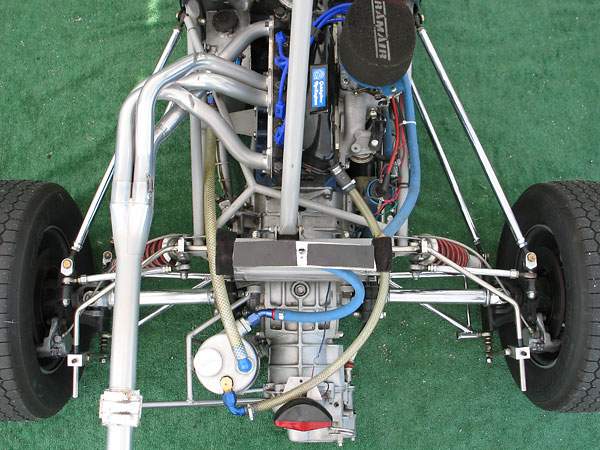
�
In overview, the Merlyn 11A rear suspension looks similar to nearly every "Formula car" of its era:
�
inverted lower wishbones, single top links, and twin adjustable trailing links.
�
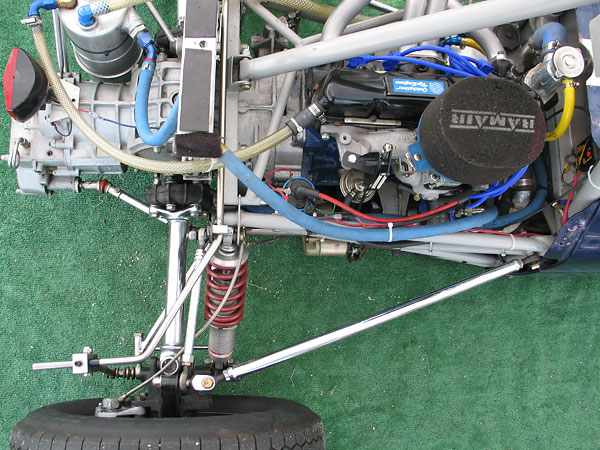
�
All eight rear suspension pick-up points on the Merlyn 11A frame are in single shear.
�
Contrast this, for example, with son�
Scott's Royale RP3¹�
where all eight Heim joints are
�
supported by double shear connections. It's a tiny design detail, but an important one.
�
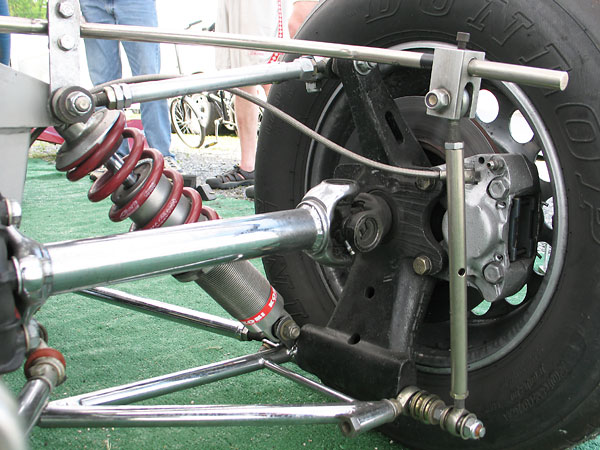
�
Koni aluminum bodied double adjustable coilover shock absorbers and Eibach springs.
�
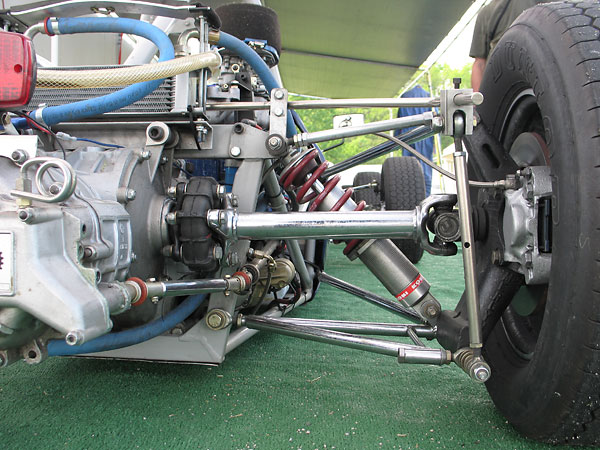
�
Rubber drive donuts were exclusively specified by Formula Ford class rules. In today's world, CV joints
�
would seem an appealing option because they're maintenance free and they should last much longer.
�
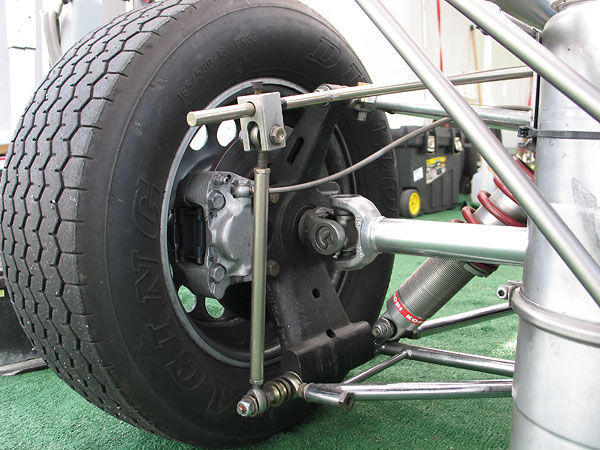
�
Merlyn's proprietary cast magnesium rear uprights, and an adjustable anti-roll bar.
�
�
Interior
��
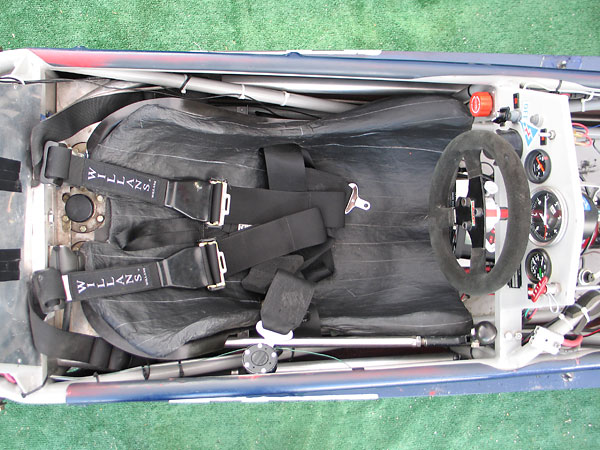
�
Custom-fitted drivers seat.
�
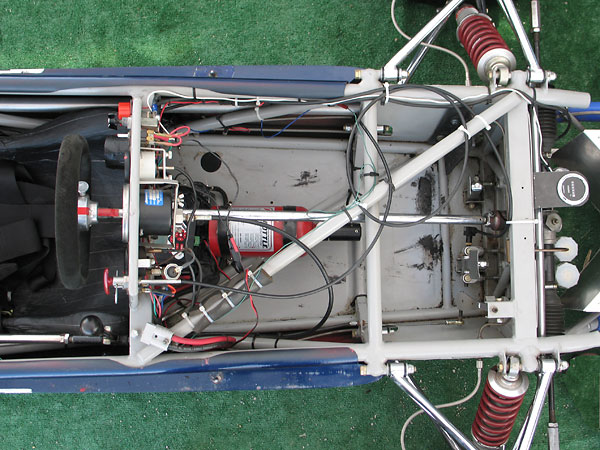
�
FireBottle fire suppression system.
�
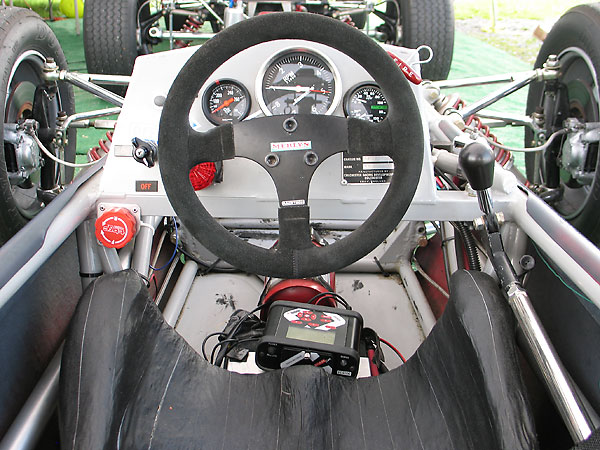
�
RaceTech suede covered steering wheel.
�
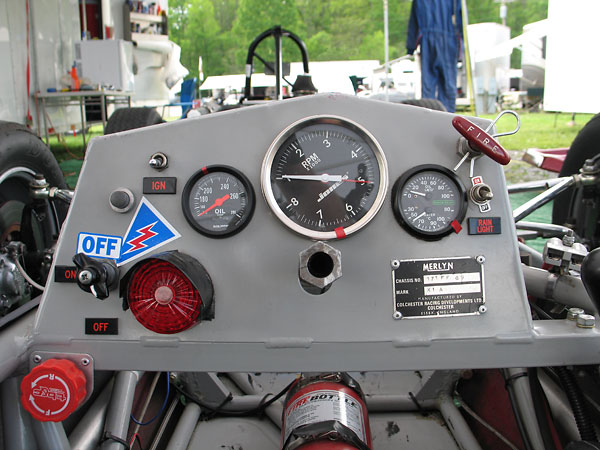
�
AutoMeter oil temperature gauge (140-280F), Jones tachometer (1000-8000rpm), and
�
Racetech dual oil pressure (0-100psi) and coolant temperature (30-110C) gauge.
�
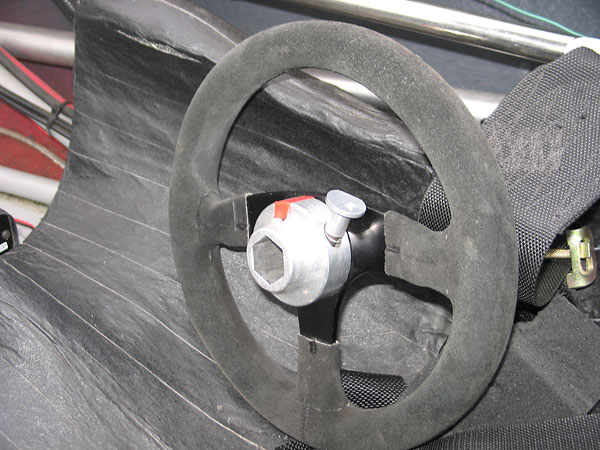
�
Quick release steering wheel hub.
�
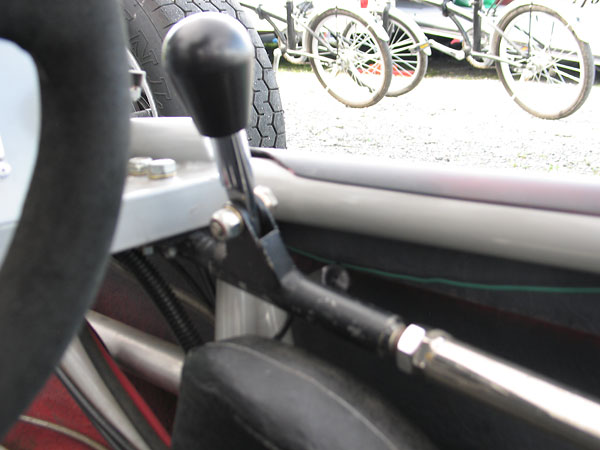
�
Merlyn 11A gear selector lever.
�
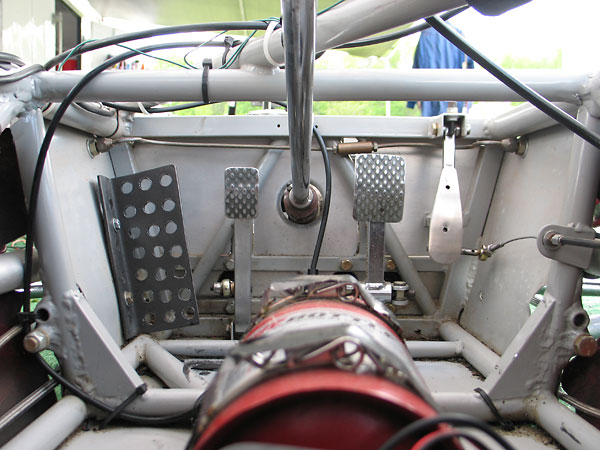
�
Merlyn 11A footbox.
�
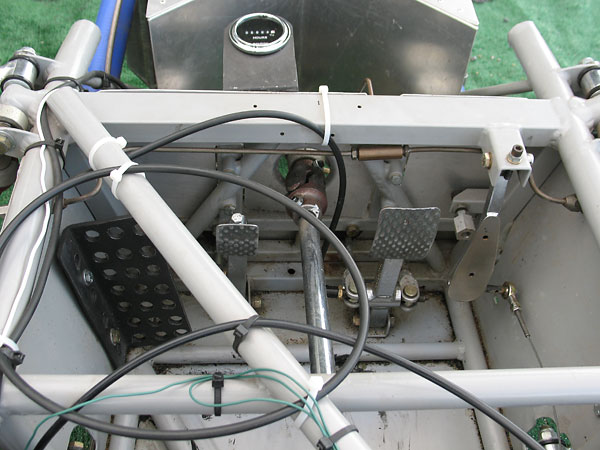
�
AutoMeter hour meter (mounted on front bulkhead), showing 8.7 hours elapsed.
�
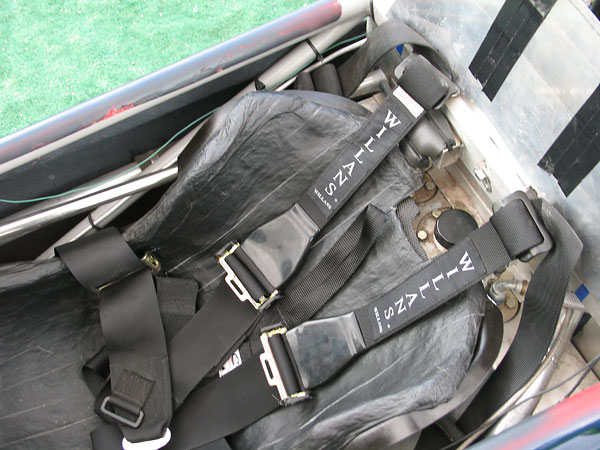
�
Willans six-point cam-lock safety harness.
�
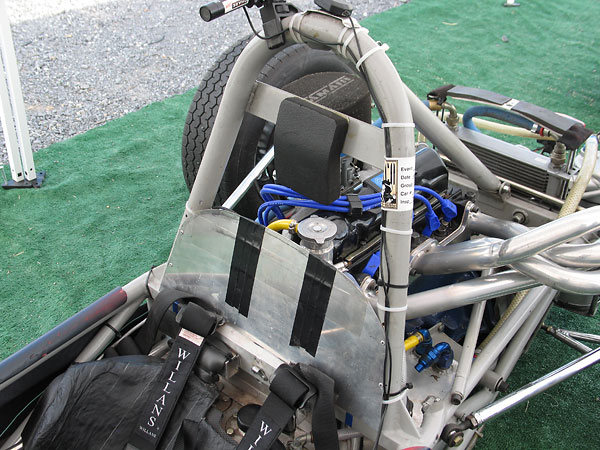
�
Padded head rest, and raised roll hoop.
�
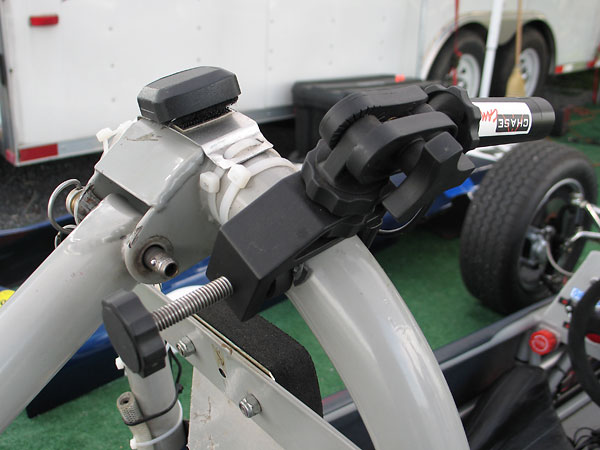
�
Chase Cam camera bracket.
�
�
Exterior
��
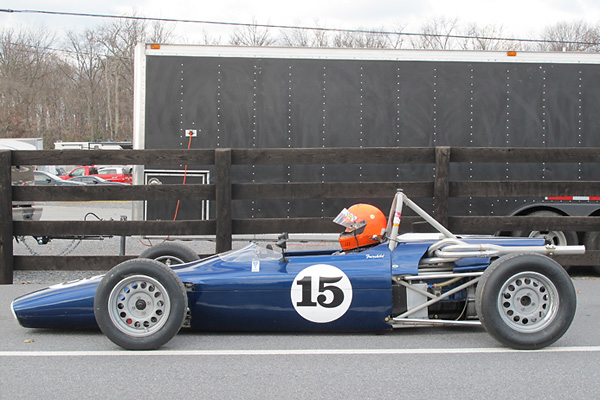
�
Merlyn produced especially attractively styled Formula Fords.
�
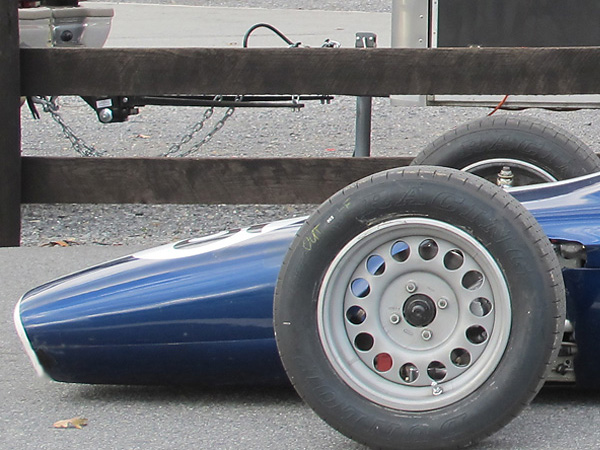
�
Steel disc wheels, as traditionally required by Formula Ford class rules.
�
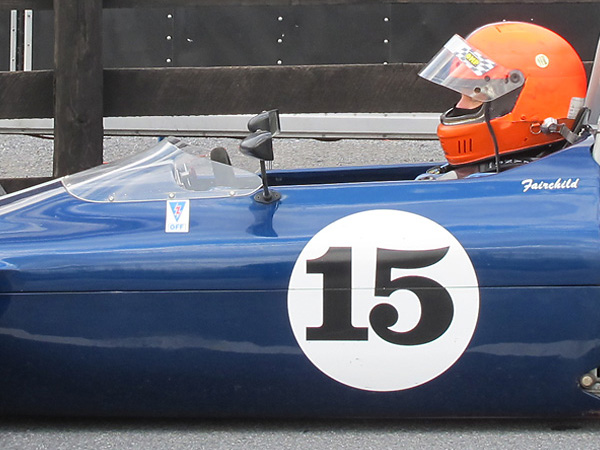
�
Most days he's a banker... in daydreams he might be the next Emerson Fittipaldi or Jody Scheckter.
�
Even in "vintage" events, Formula Ford remains a particularly competitive racing class; one that
�
especially rewards skill, athleticism, courage, and concentration.
�
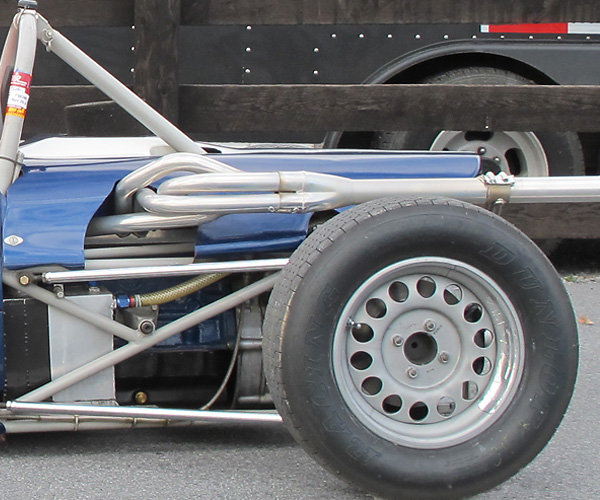
�
Dunlop Racing "Formula Ford" tires (135/545-13 CR82 front, 165/580-13 CR82 rear).
�
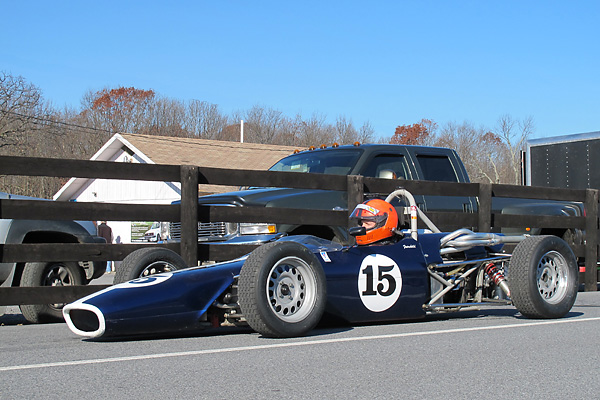
�
Class of 1969: Merlyn's 11A model Formula Ford racecar.
�
| Notes: | |||||||
| (1) | �
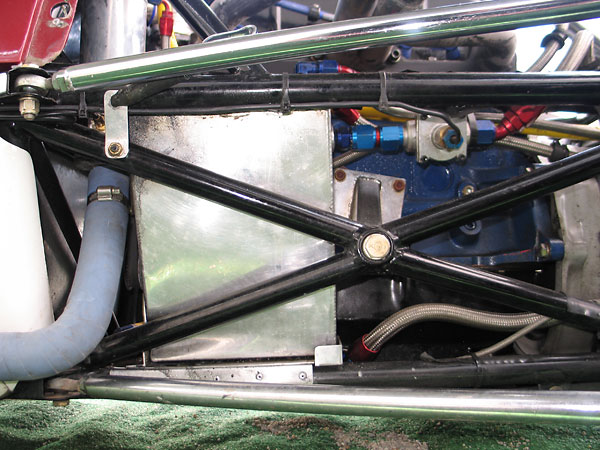 � Fasteners are said to be utilized in "single shear" as opposed to "double shear" when strain on the fastener� in question is applied to just one shear plane as opposed to two shear planes respectively. In the latter� case - illustrated here with trailing link brackets on a Royale RP3-A Formula Ford - the cross-sectional� area of strain is literally twice as large and therefore twice as strong. In practice, double shear connections� are usually even more than twice as robust. In the case of bolted joints, double shear connection makes it� easier for the designer to ensure thread roots won't be aligned with a shear plane. � � | ||||||
�
All photos shown here are from April 2010 when we viewed the car at VRG's Jefferson 500�
at Summit Point Motorsports Park, West Virginia. Photos by Curtis Jacobson for BritishRaceCar.com, �
copyright 2010. All rights reserved.
�
| If you liked this article, you'll probably also enjoy these: | �|||||
 | �
Dick Leehr 1968 Lotus 51c | �
 | �
Jeff Snook 1968 Alexis Mk14 | �
 | �
Scott Fairchild 1972 Royale RP3A | �
| You're invited to discuss anything you've seen here on The British Racecar Motorsports Forum! | �|||||
�
Notice: all the articles and almost all the photos on BritishRacecar.com are by Curtis Jacobson.
�
(Photos that aren't by Curtis are explicitly credited.) Reproduction without prior written permission is prohibited.
�
Contact us to purchase images or reproduction permission. Higher resolution images are optionally available.
�

 �
�